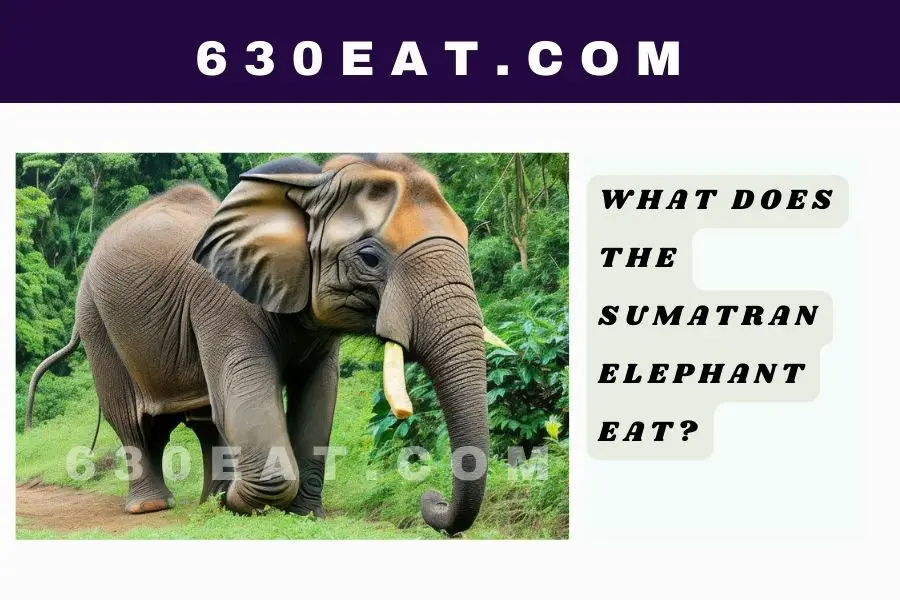The Sumatran elephant is a fascinating and majestic creature. Sumatran elephants, a unique subspecies of Asian elephants, have a strong reliance on their dietary habits for their preservation and wellness. This majestic species resides on the Indonesian island of Sumatra and depend on the sustenance it finds in the wild.
This article delves into the fascinating dietary habits of the Sumatran elephant, offering a comparison of its diet to that of other elephant species, as well as providing insight into the importance of its dietary habits to ongoing conservation efforts.
Understanding the Sumatran Elephant
In order to gain insight into the eating habits of the Sumatran elephant, it is important to first understand its habitat, physical characteristics, and social behavior. This will provide a foundation for discussing the specifics of its dietary habits and how they relate to the overall well-being of the species.
Habitat and Distribution
The Sumatran elephant primarily lives in the tropical rainforests of Sumatra, the sixth-largest island in the world. Its range was once widespread across the island, but due to habitat destruction and fragmentation, its population has been significantly reduced and isolated to a few forested areas.
These remaining pockets of habitat are critical to their survival and are home to a variety of flora and fauna that the Sumatran elephant relies on for sustenance. The richness of the rainforest environment provides an abundance of food sources that contribute to their diverse diet.
Physical Characteristics
Sumatran elephants are generally smaller than their African counterparts. They have relatively larger ears, and the females often lack visible tusks. Males, on the other hand, tend to have a pair of tusks which are more prominent. The average Sumatran elephant stands over 2.5 meters at the shoulder and weighs between 2 and 4.5 tons.
These physical characteristics are important to consider when discussing their dietary habits as they must consume enough food to maintain their size and energy levels. Additionally, their large size allows them to reach various heights within the forest to access a wider range of food sources.
Social Behavior
Sumatran elephants are highly social animals that live in matriarchal groups consisting of females and their offspring. Males typically leave the group as they mature and form smaller, bachelor groups or lead solitary lives. These social structures have a significant impact on their feeding habits, as they often coordinate group foraging efforts to find food and protect one another from potential threats.
The Sumatran Elephant’s Diet
Now that we have an understanding of the Sumatran elephant’s basic characteristics and behaviors, we can delve into their specific dietary habits, focusing on their primary food sources, seasonal diet variations, and foraging strategies.
Primary Food Sources
Sumatran elephants are herbivores, feeding mainly on a wide variety of plant materials such as grasses, leaves, fruits, and bark. Due to the biodiversity present in their habitat, there is a large variety of plant species that they consume, including over 100 species of trees and plants.
Bamboo, palm leaves, and various types of grasses tend to be some of the primary staples in their diet. However, they also consume fruits like bananas and jackfruits, as well as the young shoots and leaves of many trees’ species.
Seasonal Variations in Diet
The diet of the Sumatran elephant can change depending on the season and availability of certain food sources. During the wet season, when vegetation is more abundant, they tend to consume primarily grasses and other herbaceous plants. Conversely, in the dry season, they rely more on tree bark, roots, and other more fibrous plant materials.
This adaptability in their diet allows the Sumatran elephant to survive in a fluctuating environment and ensures that they receive the necessary nutrients needed for their development and growth.
Foraging Strategies
The Sumatran elephant uses various foraging strategies to find and consume food. They utilize their trunks to pull leaves and branches from trees, as well as strip bark and pluck fruits. Additionally, they use their massive size and strength to push over trees and access more difficult-to-reach food sources, such as high branches or treetops.
During times of food scarcity, they may also resort to crop raiding, which can lead to conflicts with local farmers and communities.
The Role of Diet in Sumatran Elephant Conservation
The diet of the Sumatran elephant is not only essential to their survival but also plays a key role in their overall conservation efforts. Factors such as threats to food sources, human-elephant conflict, and conservation strategies can impact their ability to thrive in their native habitat.
Threats to Food Sources
Habitat loss and fragmentation significantly threaten the food sources available to the Sumatran elephant. Illegal logging, land conversion for agriculture, mining, and infrastructure development contribute to the depletion and degradation of their natural habitat. This can lead to food scarcity, malnutrition, and weakened immune systems, making them more susceptible to disease and other health issues.
Human-Elephant Conflict
As Sumatran elephants lose their natural habitat and food sources, they may venture closer to human-settled areas in search of sustenance. This can lead to crop raiding, property damage, and even loss of human life, further exacerbating the conflict between humans and elephants.
Efforts to reduce human-elephant conflict must focus not only on creating barriers and deterrents between elephants and communities but also on conserving and restoring their natural habitat to ensure the availability of sufficient food sources.
Conservation Efforts and Strategies
Various organizations and initiatives are working to conserve the Sumatran elephant and its habitat. These efforts include establishing protected areas, reforestation projects, and implementing sustainable land management practices to safeguard the elephant’s food sources and habitat.
By promoting awareness and advocacy for the Sumatran elephant, we can encourage ongoing efforts to conserve the species and ensure their future survival.
Comparing the Diets of Different Elephant Species
While the focus of this article is on the diet of the Sumatran elephant, it is interesting to draw comparisons between the diets of different elephant species. The variations in their dietary habits can provide insights into their adaptations to unique habitats and ecological niches.
African Elephant vs. Sumatran Elephant
African elephants, the largest of the elephant species, also have a diverse diet, primarily consisting of grasses, leaves, fruits, and bark. However, due to the more arid and open environment they inhabit, African elephants consume a higher proportion of grasses and browse than Sumatran elephants. This difference in diet composition is an adaptation to the unique habitat conditions each species faces.
Indian Elephant vs. Sumatran Elephant
Indian elephants, another subspecies of the Asian elephant, have a diet similar to the Sumatran elephant, consuming a wide variety of plant materials. However, Indian elephants are known to have more specific seasonal preferences for certain plants compared to the Sumatran elephant. This is likely due to the greater frequency of seasonal changes in the Indian elephant’s habitat.
Borneo Elephant vs. Sumatran Elephant
The delightful Borneo elephant, sometimes referred to as the pygmy elephant, is the littlest of all elephant species, and resides in the Southeast Asian region. Their diet is similar to other Asian elephants as they consume a diverse range of plant materials. However, their smaller size likely influences the specific plants they feed upon, as they may not have access to taller trees and vegetation like their larger relatives.
Conclusion
In conclusion, the Sumatran elephant is a remarkable species with a diverse and adaptable diet that contributes to their survival. Recognizing the importance of their diet and conserving their habitat will play a crucial role in ensuring their future existence.



